The KVVAK trip to China - Travel Diary by Alice Rijkels
I take a peek in the shop of the hotel - should I buy something? Well…there are no Guanyin here. They do have the shiny translucent, high-white Dehua porcelain, which I understand much better since yesterday; this is the Jian White porcelain, of which the body and the glaze are highly integrated; it is very white.
We will be driving from Dehua to Fuzhou today. Emotional for me to leave Dehua county behind, this place is very special to me, just the beauty of the porcelain. Now already leaving behind this county full of kilns and sherds and a brilliant museum and kind people.
We travel through the green and beautiful and mountainous landscape, and stop at a fuel tank station. Between the Coca Cola machine and a small plant three statues are exhibited for sale, two ancient emperors from unknown dynasties and Mao. Ting-tiang buys cakes; Carl crackers.
After three hours of driving through the lush landscape we arrive at
Friday October 21, 2016
Fuzhou
I take a peek in the shop of the hotel - should I buy something? Well…there are no Guanyin here. They do have the shiny translucent, high-white Dehua porcelain, which I understand much better since yesterday; this is the Jian White porcelain, of which the body and the glaze are highly integrated; it is very white.
We will be driving from Dehua to Fuzhou today. Emotional for me to leave Dehua county behind, this place is very special to me, just the beauty of the porcelain. Now already leaving behind this county full of kilns and sherds and a brilliant museum and kind people.
We travel through the green and beautiful and mountainous landscape, and stop at a fuel tank station. Between the Coca Cola machine and a small plant three statues are exhibited for sale, two ancient emperors from unknown dynasties and Mao. Ting-tiang buys cakes; Carl crackers.
After three hours of driving through the lush landscape we arrive at

the Lakeside hotel in Fuzhou. The sky is overcast; it is very humid and hot here. Fuzhou is a city with an old harbor; it was founded in 202 BC and has been an administrative center since the Qin Dynasty. Marco Polo visited around 1290. In the era of tea clippers, Fuzhou exported more tea than any other harbor in China. Much of the best tea came from the Wuyi Mountain area, up the river from Fuzhou.
We have been driving a lot. All of a sudden I have to think of a song that came out in the sixties: “I am a road runner, honey….you can’t keep up with me!” That surely applies to our group as well.
The hotel is located on the shore of a lake, it is an American looking building, the frontside is a mirror reflecting the skies and clouds. It has a huge marble hall filled with business people. While Sou takes care of the bookings we take lunch. I feel tired; I swallow food from the buffet, but also snap at the group and the waiters. Guess it must be the heat; never good to snap, so I go up to the 9th floor of the hotel to find my room. There reigns peace and quiet, but the air is still humid ; I take a shower and change clothes.
Downstairs, we meet again In the big hall and take a walk through the park. The Lake park is nice and calms us down; we pass through a
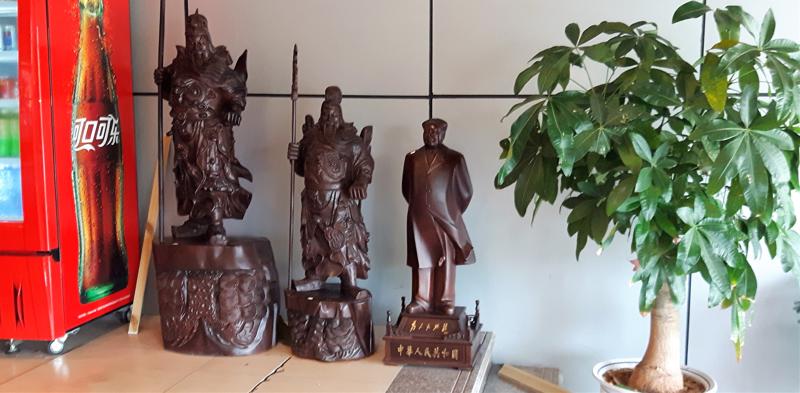
gate onto wooden bridges leading us around the lake. My speed is limited today I am kind of lagging behind and try to breathe, still being proud of the energy in the group. We go to an excellent Museum: the Fujian Provincial Museum. It was built in 2005 in Fujian style for multiple types of research.
We will have about 2.5 hours to spend here. An archaeologist named Wang joins our group; Christine will have a meeting with a professor for her studies.
There is a huge black glazed porcelain vase shown in the hall. I start with the exhibition on the civilization of Fujian. Splendid! The types of porcelain on show here are all so beautiful, it is such a perfect collection and there are English texts for detailed information. I read the text on the wall:
“When the central plains entered into the Bronze Age the seven tribes of Fujian created distinctive local culture, the ritual culture of the Central Plains and the Wu and Chu culture had a profound influence on the established Fujian culture”. We are only here at an hour’s drive from the East coast and the Ocean, Nigel Wood explains the Chinese view on these cultures very well in his book on glazes, but I do not have it with me. We also admire the museum’s permanent
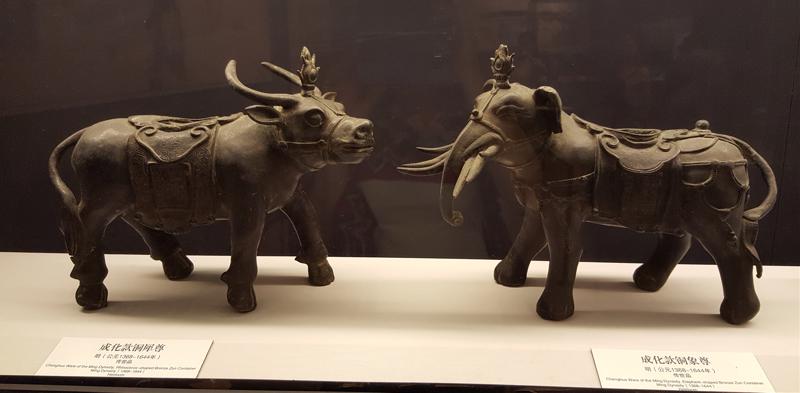


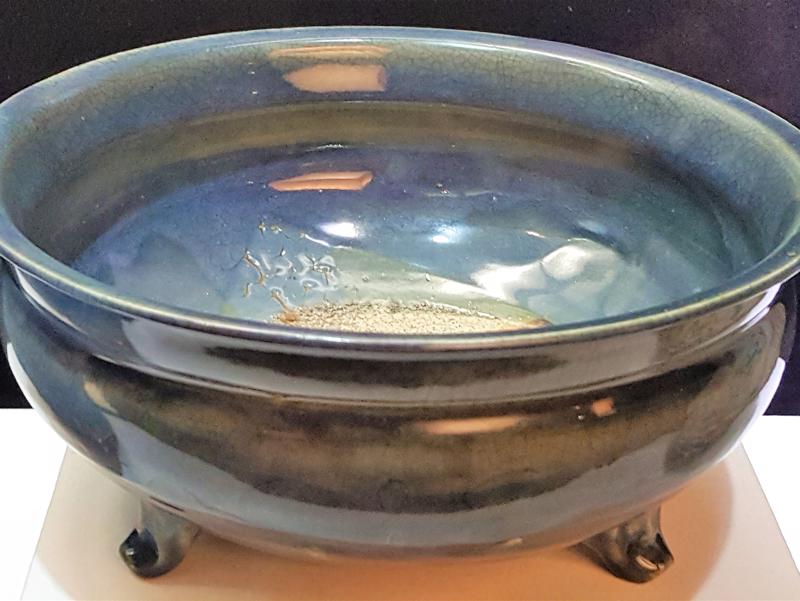
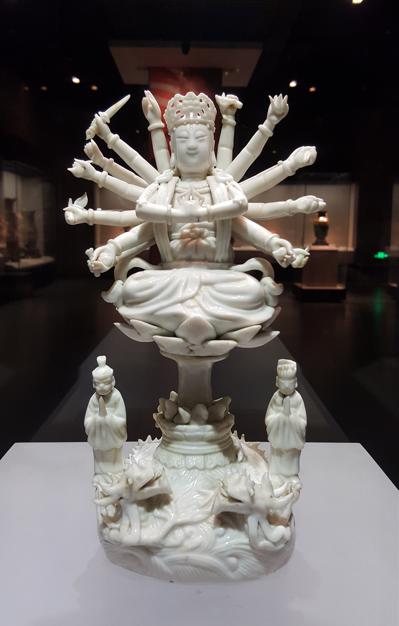

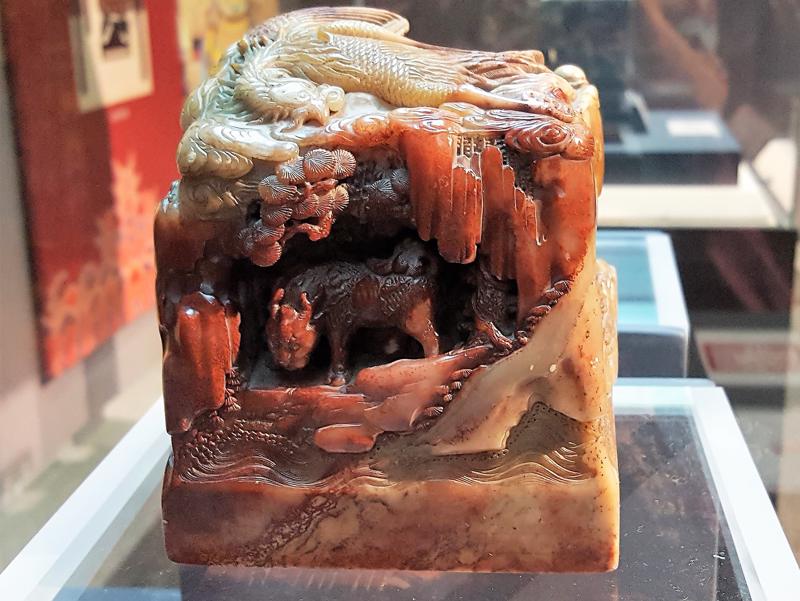
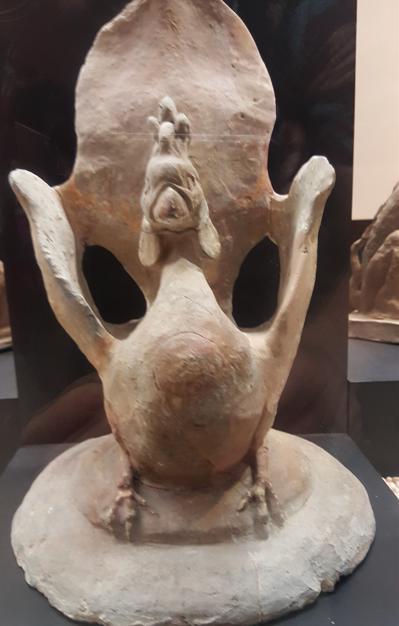




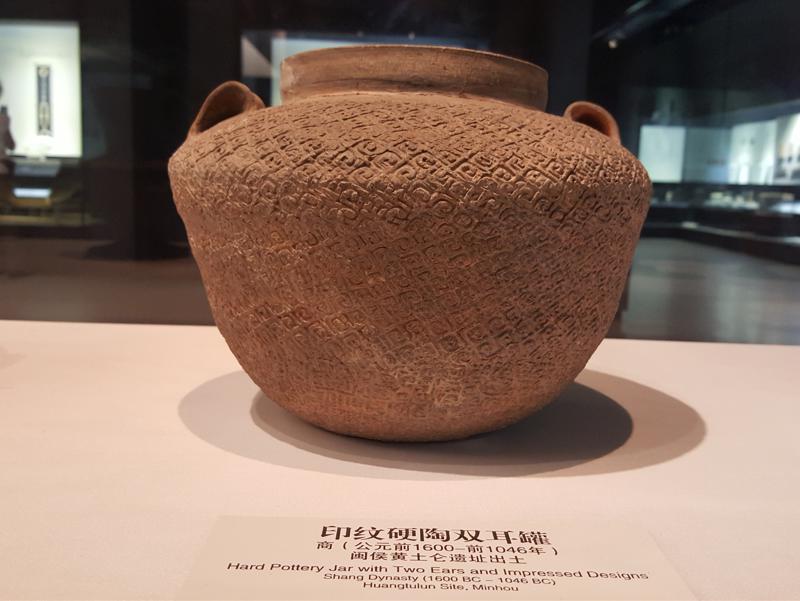
exhibition called “Porcelain exports in the history of Fujian”.
I wish I knew more; standing here reading I am starting to catch up. There are two Neolithic cups shown from 5000 – 4300 BC, and can’t believe my eyes: very ancient pottery, also some jars. First time I see those from so close by; they come from Minhou.
Also a 1600 BC hard pottery Gui-shaped pot is shown, not a crack it has. And pottery with impressed design from the very old Shang dynasty, all from Minhou. Also a Western Han figure. It’s characteristic precise design is inspiring. There are lots of statues of figurines, big and small statues, birds, camels, dogs, turtels and fish from the late Tang Dynasty, many were excavated at the Liuhua Tomb at Xindian in Fuzhou. There is a gilded silver ewer from the Southern Song Xujun tomb.
The group feels very happy here. Voices echo up and down through the porcelain exhibition hall. There is tomb stone with an Arabic inscription from the Song dynasty; a beautiful white-glazed Kumdika water pot from the Southern Song from the Gaide kiln in Dehua; and a standing figure of Tathagata from Zhang kiln, made in the 35th year of the Jiajing period of the Ming dynasty, heirloom (1556). A rhinoceros-shaped bronze Zun container Chenghua ware, Ming, so beautiful. A dish with floral sprays pattern in white over blue ground from the Zhangzhou kiln of the Ming. A beautiful blue glazed tripod. A six vase blue and white from Jingdezhen, Qianlong. A green glazed

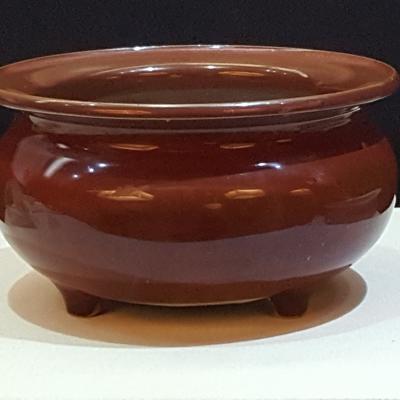

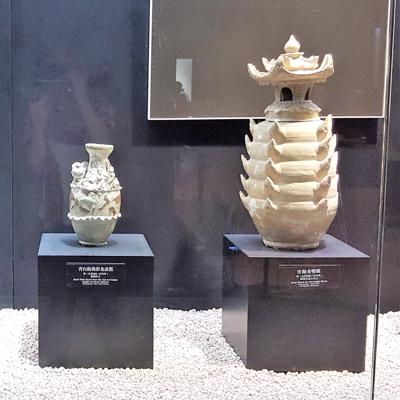
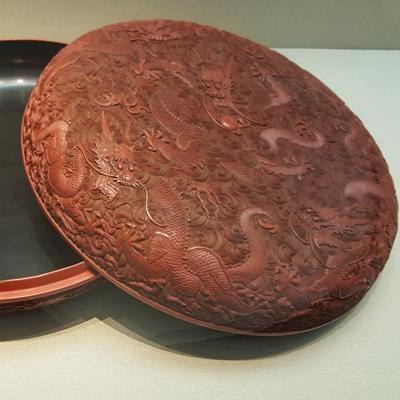
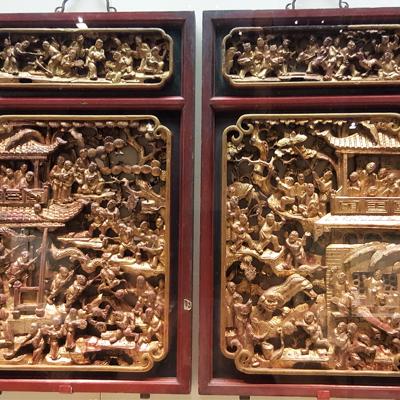

vase from Longquan, an underglaze red Yuhuchun Quing vase from Jingdezhen, a yellow dou, all collected and organized in a beautiful way.
I continue my tour buying a ticket for the exhibition named: “Return of Shoushan stone from the Imperial collection of the Palace museum”. The exhibition showcases nearly 100 imperial seals made of Shoushan stone from the Palace Museum in Beijing. Half of the objects have never been displayed to the public. Here the best stamps are on show, the marks they make are so beautiful and typical for emperors of the Qing. Another great exhibition, but all is written in Chinese characters, the marks and also the museum did not make any translations in English for this exhibition. I recognize some of the emperor seals, thanks to the pictures of the Qing emperor above the seal. The jade stamps are beautiful, unbelievable the design and the skilled carving. A piece of an imperial seal from the reign of Emperor Kangxi of the Qing Dynasty is on display, also a
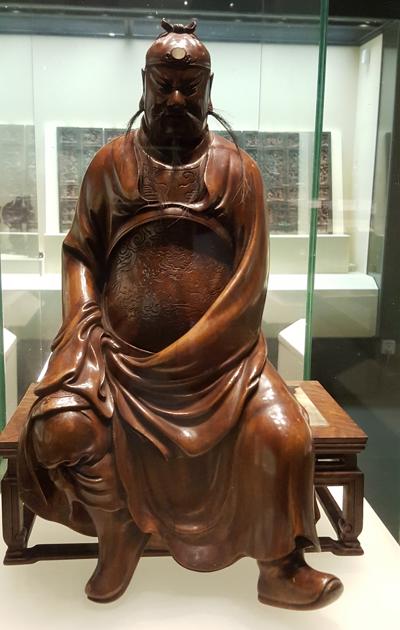
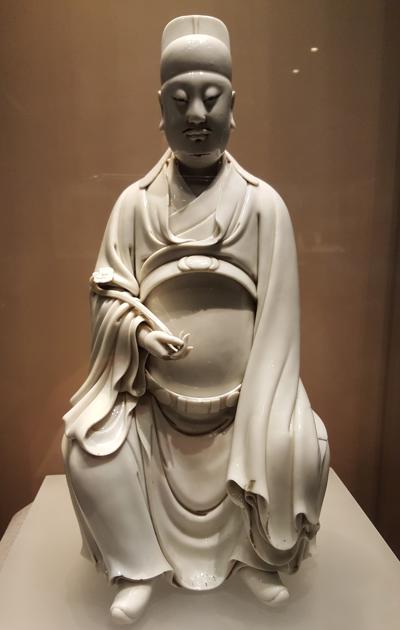
block for Yongzheng, sets of imperial seals used by Emperor Qianlong and an imperial seal known as Emperor Jiaqing's treasure.
It constantly hits me now…not being able to read Chinese during this trip, I miss a lot of information.
I lost sight of the others of the group. Some Chinese visitors enjoy viewing the seals. The craftsmanship is unbelievable. Then there are even more jade seals and colored stone objects and figurines, made by famous craftsmen, but again all information reads in Chinese.
I move on and it looks like I find myself in the permanent exhibition called “Rare Crafts (of Fujian)”. The collection is again extensive and of very high quality.
In the basement of the Museum there is an exhibition on Communism. It starts with scriptures by Lenin and Marx, also there are tools on show like seals, there is a documentary showing Mao on the red square of Bejing with Zhou Enlai and Edgar Snow. Snow wrote as an American journalist in China the book "Red Star Over China" in 1937. As in 1936 he had spent four months at the Communist headquarters at Bao'an meeting the communist leaders; he did at that time many interviews with Mao. So his book was well
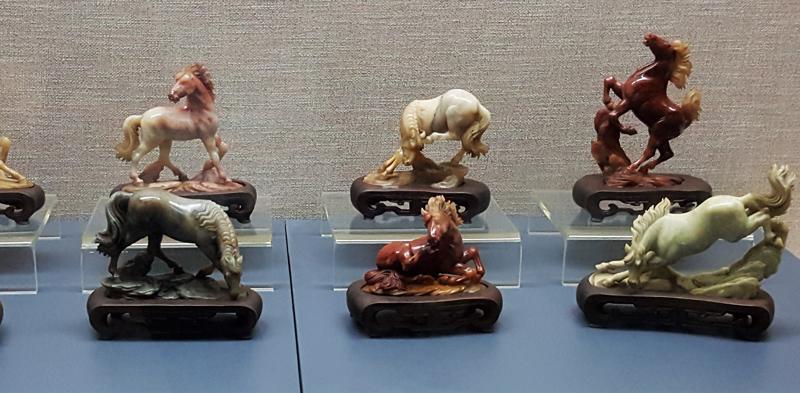
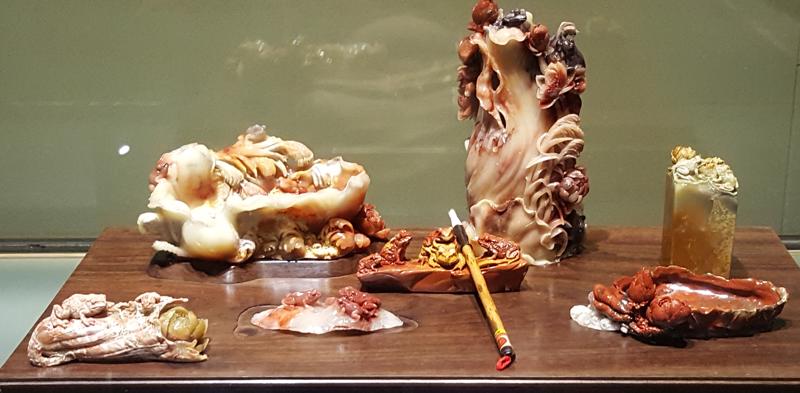
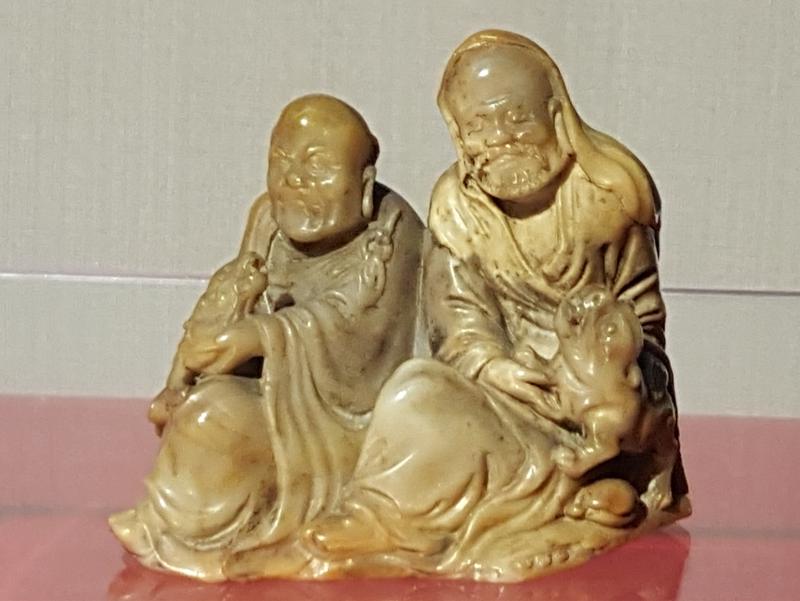
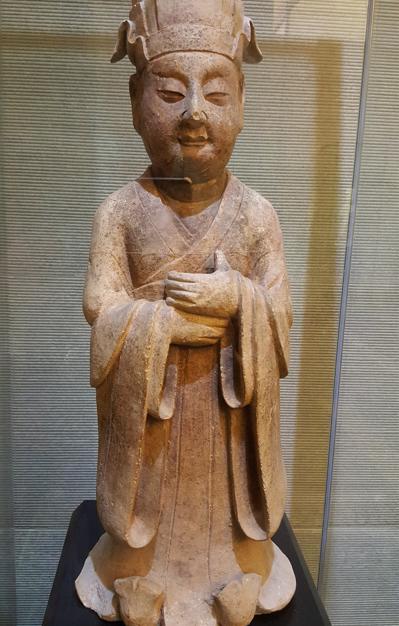
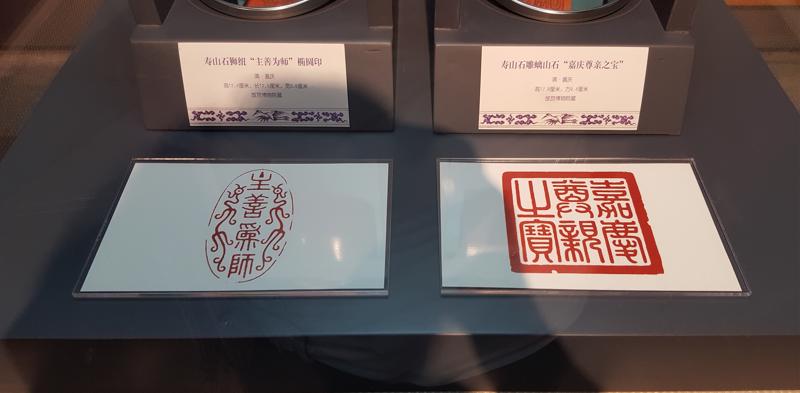
read by the Western world and was considered the best account on Communism available.
More stories of soldiers in the war and an information screen I cannot read, lots of black and white pictures and odes to uniformed men and women in war, who – as it looks - do not have a great chance of survival. It looks terrible and serious.
I am sad seeing all those pictures, but still it was good the photographer was there to capture the disaster of war. I move on to a department where there are new great artifacts, such as brushwood paintings from the Qing period. Brushwood is one of the three treasures of Fuzhou artworks. It displays a poetic and picturesque splendor through the color of primitive simplicity and fine carving technique. It was first produced at the start of the 20th century by artist craftsmen such as Chen Chunnrun, Zheng Lixi and Wu Xiqi on the bark of cork oak trees imported from Spain, Portugal and other Mediterranean countries. It is also called softwood and its propriety is, that is has soft skin, with a fine grain and elegant color.
By using a knife instead of a painting brush and through circular carving, relief and open work carving and miniature carving, the artists were able to use traditional carving techniques with the
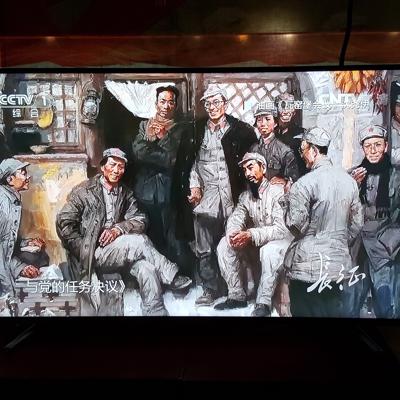
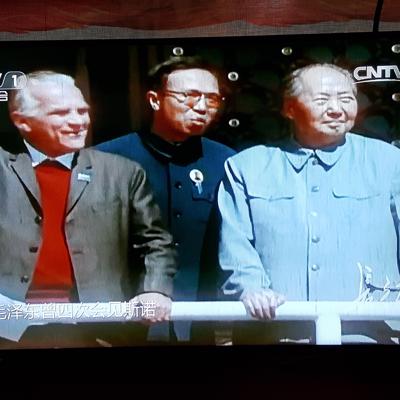
profound artistic conception of the Chinese way of paintng, they were usually put in frames or screens of different shapes or sizes to create flat or three dimensional effects. The subject matter includes world scenery, places of historic interest, human figures of animals.
And there is a great statue of an 18-armed Candi Avalokitesvara from the Dehua kiln – Ming period; now that we have already seen them in Dehua and received an explanation about them we already know about their popularity during the Ming period: it was because of their splendid whiteness and beautiful style. Also the Modern Times artist Chen Dairu with Eight mortals crossing the sea I like very much, and the Guanyin holding a child surrounded by children is also from Dehua and made during the Ming. Also on show are gold lacquered wood boards with the Eight Immortals. Many gold lacquered boards are exhibited here and statues, lovely gold lacquered statues from the Qing, soooo beautiful, cannot believe my eyes. There is so much more.
Difficult to leave this department, but the museum’s microphone voice asks us to leave, so I hurry upstairs for buying a brilliant catalogue. This makes me sooooo happy. Seems I am the last leaving this
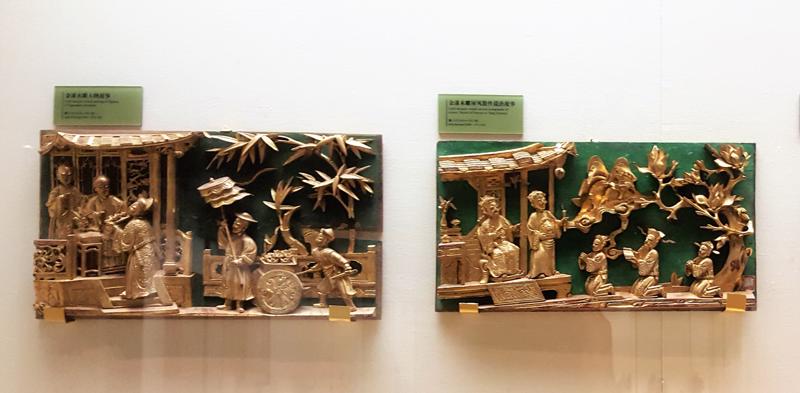
museum again, with several guards hissing at my back to chase me out. I am now descending the enormous white stairs of the Museum. A big voice calls out “AAAAALLLLIIICCCEE”, it is Carl calling out to me from the Park, Ting-tiang hurries up to me… where was I??? I excuse myself, getting late out of a Museum again, a Museum we loved very much. The humid afternoon feels like a hot sauna; the overcast skies at the other side of the Lakeside hotel mirrors the big clouds.
Near the Museum we have left Christine behind with a tutor she knows well and who guides her to get info on the archaeological department. Relaxed and enthusiastic we walk back through the Park and over the wooden side bridges. We are not allowed to swim here, unfortunately… too much poison. I follow Carl and Truke back to the Hotel, we pass along the lake while the sun starts setting behind the mountains. It is so humid and hot here; it even triggers some of our group into talking about their youth and other intimate information.
It is swimming time, but there is no swimming pool here at the hotel. Through my room window, I note there is a swimming pool on the roof of the hotel on the other side of the street. Changing clothes I

note some “interesting” irritation on my ankles – I have about 30 mosquito bites. So being unfocussed and with all those bites I decide to cancel dinner and plan to go to the hotel on the other side for a swim on the roof top. In that hotel, I get a lot of selfie requests from the guests, but no access to its swimming pool. Finally I find a pool in a pompous C&D hotel, I look weird in the big hall with my bikini under my shirt. I pay some yuans to the receptionist, who gives me a ticket and takes me through a huge hall and garden to an indoor Olympic type of swimming pool. Now I feel happy; I can swim some miles and there is no one in the pool except me and a Chinese man, who swims along with me. It is so relaxing to be here! What luck! There are two guides seated on benches who control and overlook the area…and jump up high when at the end of my swimming rounds I leave the pool and nearly enter the gentlemens’ instead of the ladies changing rooms. In the ladies department, under the showers, a lady is curious as to how my skin looks, watching freckles on my arms and shoulders from so close by, I wait patiently for her to take a step back. It feels strange to be part of a minority; it makes one realize what it feels like if people check the color of your skin for example.
Walking back to the hotel I lose my way and end up in the catacombs of the hotel where the cooks are cooking, in the steaming hot kitchen

and where the ladies run around with fresh cotton sheets for the beds. My Chinese is still not good enough, but I have a good time with the personnel who are so kind to bring me back to the elevator area. Back in my room I call Pieter. Oooh, how could I have left alone my husband I ask myself? And how are my friends doing? I’d better go eat in order not to think about it. I am not Chinese: do I get the food I ask for? - again I am being served an amount of rice for three persons and an amount of Broccoli for five. I miss Wai Lan doing the orders for me, and the group under which wings to hide while all the new information slowly fixes itself in my brain.
The rest of the evening I spend in my room with a watercolor paint box and a watercolor notebook: I paint a small and vague drawing; it is a copy of the drawing by Guan Shanyue in the Five Story Pagoda of Guangzhou (of which I have a picture on my phone). My smartphone supplies me sometimes with You Tube music, but that happens sparsely.
A good tea is in my teapot - such a lovely night I pass here. I phone Ting-tiang; he says all are doing OK and are back in the hotel; they had a great time. Good to hear, tomorrow another day: we will see more of Fuzhou!
1.
Introduction
2.
Saturday October 15, 2016
3.
Sunday October 16, 2016
4.
Monday October 17, 2016
5.
Tuesday October 18, 2016
6.
Wednesday October 19, 2016
7.
Thursday October 20, 2016
8.
Friday October 21, 2016
9.
Saturday October 22, 2016
10.
Sunday October 23, 2016
11.
Monday October 24, 2016
12.
Tuesday October 25, 2016
13.
Wednesday October 26, 2016
14.
Thursday October 27, 2016
15.
Friday October 28, 2016
16.
Saturday October 29, 2016
17.
Sunday October 30, 2016